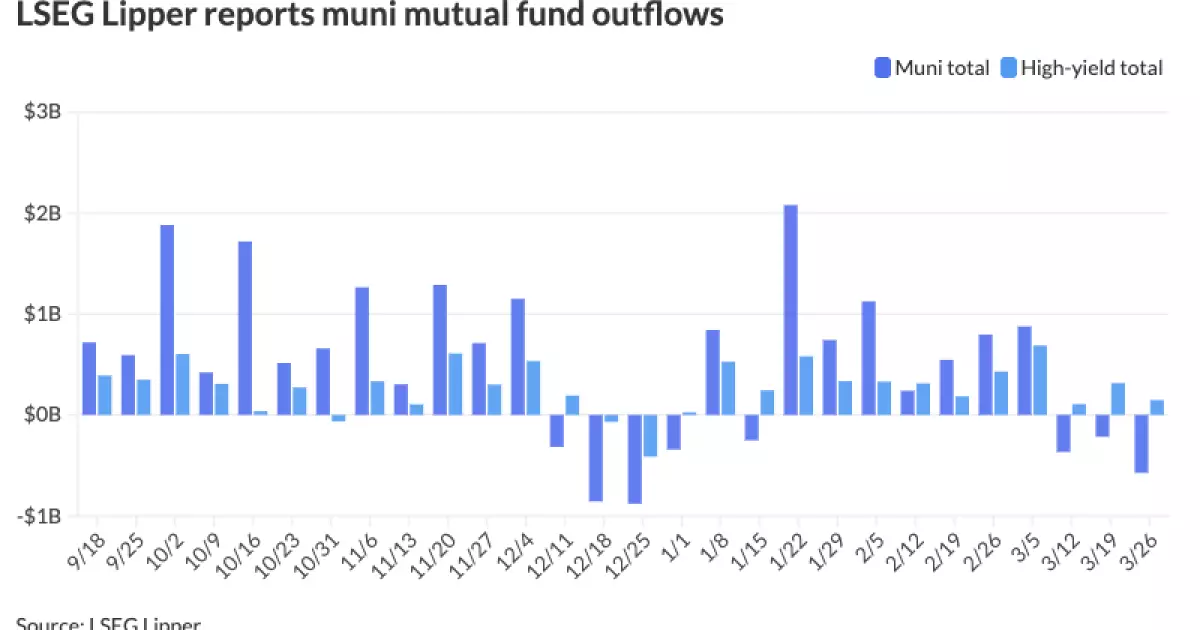The municipal bond market is currently in a phase that many analysts would describe as concerning. Recent activities paint a bleaker picture for investors, who are grappling with widening yields and an apparent lack of compelling fundamental backing. This month, municipal bonds continued to weaken, as evidenced by the slight increases in yields across various maturities. For any seasoned investor, these trends signal not just temporary setbacks but deeper structural issues within the market that are raising red flags.
According to market data at 3 p.m. EDT on Thursday, the municipal-to-U.S. Treasury (UST) ratio reflects a stark picture: 69% for the two-year, climbing to 91% for the 30-year. While ratios can fluctuate, this sustained elevation should ignite caution amongst investors. Higher ratios often signify greater relative risk or declining investor confidence in the municipal sector, prompting a painful realization that would-be serene financial waters may soon become turbulent.
Market Sentiment: A ‘One-Way Trade’ Scenario
Kim Olsan from NewSquare Capital aptly describes the prevailing sentiment as a “one-way trade up in rates.” What was once viewed as a gradual increase has now escalated into a sea of uncertainty driven by weakened fundamentals. March has marked an apparent turning point where the anticipated stability of the bond market has unraveled, replaced by looming headwinds. The stark reality is that the investment climate is heavily tilted against any optimistic outlook, and it seems that bidders are being relegated to accepting less favorable spreads in pursuit of absolute yields.
Compounding this is the growing dealer inventory, which recently hit a staggering $15.4 billion—its highest since last December. Such levels of inventory indicate that dealers are struggling to find buyers as relatively conservative investors may opt for safer, lower-yielding investments. When you consider that the short end of the yield curve has shot up by 60 basis points in just six months, it paints a grim portrait for those hoping for a swift recovery.
Market Opportunities or Traps? The Dangerous Line
Oddly enough, even in strife, some opportunities arise. The appealing yield on AAA-rated bonds exceeding 3.00% brings forth a curious dilemma for investors. While the allure of higher returns can rarely be dismissed, it is crucial to dissect the fundamental risks tied to such investments. The fact that even high-grade credits are hovering at or above the 5% threshold necessitates due diligence. Every dollar invested at these yields carries with it a heavier burden—uncertainties surrounding defaults, higher rates, and inflation concerns.
For example, recent trades from Washington State indicate a yield of 3.05% on 5s due in 2031—while this may look enticing, it arrives packaged with financial caveats that could be masking broader risks. Seeking out such opportunities might not be productive, as investors grapple with mispriced risk in an increasingly precarious environment.
Fluctuating Tax-Exempt Trends: A Divergent Path
The tax-exempt municipal market is currently experiencing flux, highlighting the nuanced differences between segments. While investors have pulled a significant $573.3 million from municipal bond mutual funds recently, high-yield categories have actually seen inflows. This divergence suggests a narrowing of focus among investors, who may believe that high-yield options, despite being riskier, offer better returns for the time being. The influx into high-yield funds raises complex questions about risk aversion and where the appetite for returns is trending.
As tax-exempt municipal money market funds accumulate $2.65 billion in inflows, the narrative becomes clearer: the pursuit of yield is strongly pulling investors, yet caution should prevail. The average yield for tax-free funds has dipped to 2.83%, revealing a waning desirability as fixed-income products become less attractive amid a rising interest rate environment.
Considerations for the Future: Navigating the Unknown
A market riddled with uncertainties poses significant challenges for investors. The reality reflects a landscape where bond prices fluctuate in response to rising yields rather than based on meaningful economic recovery signals. As municipalities increasingly issue high-yield bonds, it forces bondholders to critically assess whether risks taken are proportionate to the rewards offered.
Therefore, the core message that reverberates within the municipal bond environment is one of caution. The skepticism surrounding the current trajectory of yields is palpable, and it serves as a reminder that high yields may not accompany safe investments. As investors attempt to navigate these challenging waters, understanding market fundamentals, identifying red flags, and rationalizing investment opportunities become more essential than ever in order to avoid being swept away in a downward spiral.

